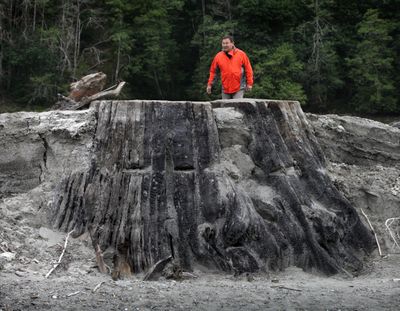Dam removal uncovers tribe’s sacred site

PORT ANGELES, Wash. — A site sacred to a Washington state tribe has been found among the 1,100 acres of land that emerged after the Elwha Dam was removed and waters receded.
Now, the Lower Elwha Klallam Tribe would like to have that land back, The Seattle Times reported today.
“A group of us walked to the site and actually stood on the rock known to us as the creation site,” said tribe chairwoman Frances Charles. “It was eerie in some ways. We were walking on the soil that had been underwater for 100 years, and witnessing the old cedars. It was emotional, with joy and happiness.”
Charles was notified by National Park Service cultural resources staff that they had found the site last month.
Long passed on in oral tradition, the sacred site is where, by tribal teaching, the Creator bathed and blessed the Klallam people, and where tribal members for generations uncounted sought to learn their future.
When Congress authorized removal of the dam southwest of Port Angeles in 1992, the so-called project lands were to be set aside either for use as a state park, a national park or a national wildlife refuge, or to be transferred to the Lower Elwha Klallam Tribe. So far, the tribe is the only eligible party that has a plan and a desire for the land.
But the site was covered by the waters behind Elwha Dam, and had not been seen by anyone in the tribe since construction of the dam between 1910 and 1913.
The park service also reported this week finding a site in another location within a former reservoir that documents human use as far back as 8,000 years ago, establishing it as one of the oldest known archaeological sites on the Olympic Peninsula. The park service collected material for analysis and reburied the site.
The National Park Service intends to launch a public process to decide the long-term disposition of the land, but at the moment has no funding to pay for an environmental assessment or environmental-impact statement, noted Todd Suess, acting superintendent for Olympic National Park.
The agency is aware the tribe wants the land but can’t just turn it over.
“We need to have a public process,” Suess said.
For now, the park service, which already manages 85 percent of the Elwha watershed, is managing the lands. Park rangers are providing law enforcement and offering interpretive walks on some of the project lands, excluding the archaeological sites, which are confidential and protected.
No matter who ends up owning the land, more than 700 acres of it along the river and in its flood plain will remain in its natural state in perpetuity, with public access maintained, according to the requirements of the 1992 Elwha Act passed by Congress.
But the tribe, if it comes to steward the lands, also would like to use some portions of the remaining property outside the archaeological sites and river corridor for housing or economic development, said Robert Elofson, director of river restoration for the tribe.
In addition to protecting the tribe’s cultural resources, transfer of the property to the tribe would help the Lower Elwha Klallam realize a long unmet need for an adequate land base, Elofson said.